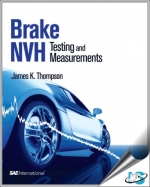Tab Article
As other vehicle systems have become more refined, more attention must be placed on brake NVH issues because they can cause a negative customer experience. From the laboratory to the road, the use of technology as well as further study by engineers is helping to lessen noise, judder, and vibration in cars.
This book provides readers with a fundamental understanding of current practices for measuring and testing brake NVH. From coverage of basic definitions and concepts to in-depth analysis of on-road testing procedures, it will serve as a comprehensive reference guide for brake test technicians, test engineers, lab managers, and others who work on making brakes quieter, smoother, more refined, and more reliable. Readers will learn how to test for brake noise, what tools to use, and which recent standards and practices have led to the successful measurement of brake noise and vibration.
Topics covered include:
- Common brake noise and vibration issues
- Instrumentation, transducers, and other technical details
- Measurement practice for laboratory and on-road testing
- Brake pad damping and natural frequencies
- Current trends in brake noise and vibration measurements


